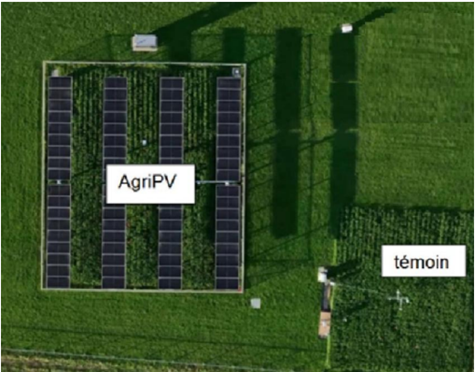New advances in agri-photovoltaics at École Polytechnique
 AgriPV – Agri-photovoltaic experimental field at École Polytechnique, illustrating the synergy between agricultural production and solar energy production.
AgriPV – Agri-photovoltaic experimental field at École Polytechnique, illustrating the synergy between agricultural production and solar energy production.
Agri-photovoltaics, or AgriPV, involves combining agricultural production and photovoltaic production on the same surface area in order to make the most of every square metre, thereby generating renewable electricity while maintaining, or even boosting, crop productivity. This innovative approach perfectly illustrates the quest to strike a balance between energy performance and agricultural sustainability.
It was with this in mind that the Chair in Technological Challenges for Responsible Energy was created in 2018, supported by École Polytechnique and its Foundation, under the direction of Philippe Drobinski, professor at École Polytechnique, CNRS research director at the Laboratory of Dynamic Meteorology (LMD*) and Director of the Energy4Climate (E4C) Interdisciplinary Centre, with the support of TotalEnergies.
This Chair is engaged in an ambitious experimental agri-photovoltaic project, the main outcome of which is the creation of a full-scale demonstrator developed at SIRTA** (Atmospheric Remote Sensing Research Site), a veritable open-air laboratory dedicated to observing and studying the interactions between the atmosphere, energy and the environment.
A two-zone demonstrator to better understand the interactions between solar panels and crops
Currently, the AgriPV demonstrator at SIRTA consists of two main areas:
• An area equipped with photovoltaic panels mounted on trackers that follow the sun's path, with alfalfa and wheat crops;
• A control area cultivated in the same way but without panels, serving as a benchmark for comparing the impact of photovoltaic installations on crops and the environment.
This system allows for concrete study of the interactions between solar panels and crops and for testing different management strategies.
Smarter tracking
Until now, panels have followed the sun's trajectory to maximise electricity production. Recent regulatory decrees encouraging agricultural production have led to a rethink of this approach. A new smart tracking strategy is being implemented, with the aim of orienting the panels more intelligently to allow more light to reach the plants according to their needs, but also for other interesting purposes (letting rain through, protecting against frost, etc.).
This experimental approach, which combines energy production and precise monitoring of crop growth with more than 80 measurement sensors (weather, electrical, soil condition, solar radiation), represents a significant step forward compared to traditional installations and could open up new prospects for sustainable agri-photovoltaics.
Establishment of a photovoltaic test area thanks to the Chair
As part of this project, a third area, called PV (Photovoltaic) control, will soon be installed, thanks to the support of the Chair. This area, which will not be used for crops, will enable analysis of the effects of vegetation on photovoltaic performance (albedo, due to the bifaciality of the panels) and comparison of the PV performance of a conventional south-facing installation with that of a typical agri-PV installation.
Thanks to the Chair's support, the demonstrator will therefore have three reference points: the AgriPV experimental area consisting of panels and crops, the agricultural control area without panels, and the PV control area without crops, thus providing a comprehensive experimental setup and a clear picture of the interactions between agriculture and photovoltaics. These advances fully reflect the objectives of the Sponsored Chairs: to promote technological and societal progress while encouraging responsible innovation.
*LMD: a joint research unit of the CNRS, ENS-PSL, Sorbonne University, École Polytechnique, Institut Polytechnique de Paris, 91120 Palaiseau, France
** The SIRTA Atmospheric Research Observatory is coordinated by the Pierre Simon Laplace Institute and supported in its operation and development by the following organisations: CNRS, École Polytechnique, UVSQ, ENPC, CEA, INERIS, EDF R&D, Météo-France
 Support l'X
Support l'X